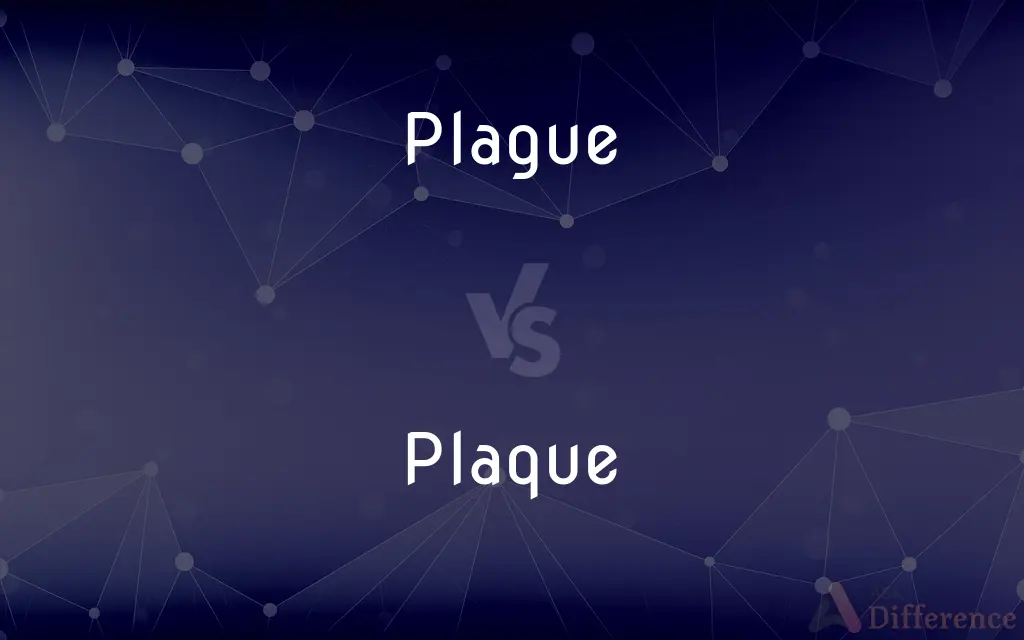Plague vs. Plaque — What's the Difference?
By Fiza Rafique & Maham Liaqat — Updated on March 17, 2024
Plague is a contagious bacterial disease, while plaque is a deposit on teeth or in arteries.

Difference Between Plague and Plaque
Table of Contents
ADVERTISEMENT
Key Differences
Plague refers to a severe and potentially deadly infectious disease caused by the bacterium Yersinia pestis. Historically, it has been responsible for devastating pandemics, including the Black Death. The disease is characterized by symptoms such as fever, chills, weakness, and swollen lymph nodes. On the other hand, plaque can refer to two main things: a sticky deposit on teeth that can lead to cavities and gum disease, or a build-up of fatty deposits inside the arteries, which can lead to cardiovascular issues.
While the plague is a biological threat that requires medical intervention and can spread rapidly through populations, dental or arterial plaque is a more localized health concern related to personal hygiene or diet. Dental plaque forms from bacteria in the mouth mixing with food particles and saliva, leading to tooth decay and gum disease if not regularly removed. Arterial plaque, composed of fats, cholesterol, and other substances, can narrow and harden arteries, increasing the risk of heart attack and stroke.
Prevention and treatment for these conditions differ significantly. Plague prevention involves public health measures, antibiotics, and reducing exposure to vectors like fleas and rodents. Dental plaque prevention focuses on oral hygiene practices such as brushing, flossing, and regular dental checkups. Managing arterial plaque involves lifestyle changes, medications to control cholesterol and blood pressure, and sometimes surgical interventions.
The historical impact of the plague has shaped societies, economies, and cultures, highlighting the devastating effects of infectious diseases on humanity. Plaque, in both its dental and arterial forms, represents ongoing health challenges related to lifestyle, diet, and aging, impacting individual health and healthcare systems.
Understanding the distinction between plague and plaque is crucial for recognizing the diverse nature of health threats, from infectious diseases that can lead to pandemics to chronic conditions that arise from lifestyle choices and biological processes.
ADVERTISEMENT
Comparison Chart
Definition
Infectious disease caused by Yersinia pestis
Deposit on teeth or in arteries
Type
Bacterial infection
Dental or arterial build-up
Prevention
Public health measures, antibiotics
Oral hygiene, lifestyle changes, medication
Impact
Historical pandemics, high mortality
Tooth decay, gum disease, cardiovascular issues
Treatment
Antibiotics, medical intervention
Dental care, lifestyle changes, surgery
Compare with Definitions
Plague
A severe infectious disease with symptoms like fever and swollen lymph nodes.
The bubonic plague was a major cause of death in medieval Europe.
Plaque
Sticky deposit on teeth leading to dental issues.
Regular brushing helps prevent the build-up of dental plaque.
Plague
Caused by the bacterium Yersinia pestis.
Researchers identified Yersinia pestis as the pathogen responsible for the plague.
Plaque
Can also refer to fatty deposits in arteries.
Arterial plaque can increase the risk of heart disease.
Plague
Can lead to pandemics with high mortality rates.
The Black Death was one of the deadliest plagues in history.
Plaque
Managed through oral hygiene and lifestyle changes.
Flossing daily is essential for removing plaque between teeth.
Plague
Requires antibiotics and public health measures for prevention.
The spread of the plague can be controlled with timely antibiotic treatment.
Plaque
Associated with chronic health conditions.
Plaque in arteries is a contributing factor to cardiovascular disease.
Plague
Historically shaped human societies and economies.
The plague had profound effects on the population and social structures of Europe.
Plaque
Prevention involves regular checkups and diet control.
Reducing saturated fats in the diet can help manage arterial plaque.
Plague
To pester or annoy persistently or incessantly.
Plaque
An ornamental tablet, typically of metal, porcelain, or wood, that is fixed to a wall or other surface in commemoration of a person or event.
Plague
A highly infectious epidemic disease, especially one with a high rate of fatality; a pestilence.
Plaque
A sticky deposit on teeth in which bacteria proliferate
Plaque around gum margins can lead to gingivitis
Plague
A virulent, infectious disease that is caused by the bacterium Yersinia pestis (syn. Pasteurella pestis) and is transmitted primarily by the bite of fleas from an infected rodent, especially a rat. In humans it occurs in bubonic form, marked by lymph node enlargement, and in pneumonic form, marked by infection of the lungs, and can progress to septicemia.
Plaque
A small, distinct, typically raised patch or region on or within the body resulting from local damage or deposition of material, such as a fatty deposit on an artery wall in atherosclerosis or a site of localized damage of brain tissue in Alzheimer's disease.
Plague
A widespread affliction or calamity seen as divine retribution.
Plaque
A flat counter used in gambling.
Plague
An influx or large number of destructive or unwanted things, especially animals
“The vines flourished, the only problem being a plague of jackrabbits” (Paul Lukacs).
Plaque
A flat plate, slab, or disk that is ornamented or engraved for mounting, as on a wall for decoration or on a monument for information.
Plague
Something that causes persistent hardship, trouble, or annoyance
“The plague of every funnyman's success is that deep down, almost everyone thinks they know forty guys funnier” (Ross Vachon).
Plaque
A small pin or brooch worn as an ornament or a badge of membership.
Plague
To cause suffering or hardship for
“Runaway inflation further plagued the wage- or salary-earner” (Edwin O. Reischauer).
Plaque
A scaly patch on a body part, especially the skin.
Plague
To be a widespread or continuous problem or defect in
Confusing jargon plagues the entire subject.
Plaque
A biofilm of bacteria in a matrix of polysaccharides and other substances on the surface of a tooth or teeth.
Plague
(often used with the, sometimes capitalized: the Plague) The bubonic plague, the pestilent disease caused by the virulent bacterium Yersinia pestis.
Plaque
A deposit of fatty material on the inner lining of an arterial wall, characteristic of atherosclerosis.
Plague
(pathology) An epidemic or pandemic caused by any pestilence, but specifically by the above disease.
Plaque
The material that such a deposit is composed of.
Plague
A widespread affliction, calamity or destructive influx, especially when seen as divine retribution.
Ten Biblical plagues over Egypt, ranging from locusts to the death of the crown prince, finally forced Pharaoh to let Moses's people go.
Plaque
A deposit consisting mainly of beta-amyloid and degenerating nerve tissue, found in the brain tissue of people with Alzheimer's disease.
Plague
(figurative) A grave nuisance, whatever greatly irritates.
Bart is an utter plague; his pranks never cease.
Plaque
A sharply defined zone of demyelination in the central nervous system characteristic of multiple sclerosis.
Plague
(ornithology) A group of common grackles.
Plaque
A clear, often round patch of lysed cells in an otherwise opaque layer of a bacteria or cell culture.
Plague
(transitive) To harass, pester or annoy someone persistently or incessantly.
Plaque
(countable) Any flat, thin piece of clay, ivory, metal, etc., used for ornament, or for painting pictures upon, as a dish, plate, slab, etc., hung upon a wall; also, a smaller decoration worn by a person, such as a brooch.
Plague
(transitive) To afflict with a disease or other calamity.
Natural catastrophes plagued the colonists till they abandoned the pestilent marshland.
Plaque
(countable) A piece of flat metal with writing on it, attached to a building, monument, or other structure to remind people of a person or an event.
Plague
That which smites, wounds, or troubles; a blow; a calamity; any afflictive evil or torment; a great trail or vexation.
And men blasphemed God for the plague of hail.
The different plague of each calamity.
Plaque
(countable) A small card representing an amount of money, used for betting in casinos; a sort of gaming chip.
Plague
An acute malignant contagious fever, that often prevails in Egypt, Syria, and Turkey, and has at times visited the large cities of Europe with frightful mortality; hence, any pestilence; as, the great London plague.
Plaque
A clearing in a bacterial lawn caused by a virus.
Plague
To infest or afflict with disease, calamity, or natural evil of any kind.
Thus were they plaguedAnd worn with famine.
Plaque
In the Hornbostel–Sachs classification system: any flat, thin musical instrument.
Blown plaques
Aconcussion plaques
Plague
Fig.: To vex; to tease; to harass.
She will plague the man that loves her most.
Plaque
A broad patch of abnormal tissue distinguishable from surrounding tissue, especially a broad irritated]] patch on the skin.
Plague
A serious (sometimes fatal) infection of rodents caused by Yersinia pestis and accidentally transmitted to humans by the bite of an infected rat flea (especially bubonic plague)
Plaque
An abnormal accumulation of material in or on an organ of the body, often associated with disease.
Amyloid plaque
Apleural plaque
Asenile plaque
Plague
Any epidemic disease with a high death rate
Plaque
An accumulation in artery walls made up of macrophage cells and debris containing lipids, (cholesterol and fatty acids), calcium, and connective tissue; an atheroma.
Plague
A swarm of insects that attack plants;
A plague of grasshoppers
Plaque
An accumulation of biofilm, or bacteria, on teeth, which may develop into dental calculus (tartar).
Plague
Any large scale calamity (especially when thought to be sent by God)
Plaque
A deposit of beta-amyloid protein occurring in a nerve cell and associated with Alzheimer's disease.
Plague
An annoyance;
Those children are a damn plague
Plaque
Any flat, thin piece of metal, clay, ivory, or the like, used for ornament, or for painting pictures upon, as a slab, plate, dish, or the like, hung upon a wall; also, a smaller decoration worn on the person, as a brooch.
Plague
Cause to suffer a blight;
Too much rain may blight the garden with mold
Plaque
(pathology) a small abnormal patch on or inside the body
Plague
Annoy continually or chronically;
He is known to harry his staff when he is overworked
This man harasses his female co-workers
Plaque
A memorial made of brass
Common Curiosities
Is plague still a threat today?
While less common, plague outbreaks still occur in some parts of the world but can be treated effectively with antibiotics.
What are the types of plague?
The three main forms are bubonic, pneumonic, and septicemic plague, each affecting different parts of the body.
How can plaque in arteries be detected?
Arterial plaque can be detected through medical imaging tests such as angiograms, ultrasounds, or CT scans.
What causes plaque on teeth?
Dental plaque is caused by the accumulation of bacteria, food particles, and saliva on the teeth.
Can dental plaque lead to other health issues?
Yes, if left untreated, dental plaque can lead to gum disease, tooth decay, and may contribute to heart disease.
How did societies historically respond to plague outbreaks?
Historical responses varied, including quarantine measures, burning belongings of the infected, and mass burials.
Can plaque in arteries be completely removed?
While lifestyle changes and medications can reduce arterial plaque, some cases may require surgical interventions like angioplasty.
Is there a vaccine for plague?
Vaccines for plague exist but are typically reserved for high-risk individuals or those exposed to the disease.
What are the complications of untreated arterial plaque?
Untreated arterial plaque can lead to serious complications like heart attack, stroke, and peripheral artery disease.
What lifestyle changes can reduce arterial plaque?
Eating a healthy diet, exercising regularly, quitting smoking, and managing stress can help reduce arterial plaque.
Did any positive societal changes result from plague pandemics?
Some historians suggest that plague pandemics led to labor reforms, wage increases, and advancements in public health infrastructure.
How often should one clean their teeth to prevent plaque build-up?
It's recommended to brush teeth twice a day and floss daily to prevent plaque build-up.
What is the role of diet in preventing dental plaque?
A diet low in sugar and high in fruits, vegetables, and fiber can help prevent dental plaque formation.
How does fluoride help in preventing dental plaque?
Fluoride helps prevent dental plaque by strengthening tooth enamel, making it more resistant to acid attacks from bacteria.
How did the plague influence art and literature?
The plague influenced a wide range of art and literature, often depicting the human condition and themes of mortality and suffering.
Share Your Discovery

Previous Comparison
Groan vs. Mutter
Next Comparison
Inductor vs. ConductorAuthor Spotlight
Written by
Fiza RafiqueFiza Rafique is a skilled content writer at AskDifference.com, where she meticulously refines and enhances written pieces. Drawing from her vast editorial expertise, Fiza ensures clarity, accuracy, and precision in every article. Passionate about language, she continually seeks to elevate the quality of content for readers worldwide.
Co-written by
Maham Liaqat













































